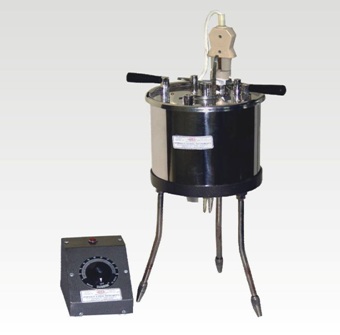AIM OF THE EXPERIMENT
To determine the viscosity of bituminous material.
CODE OF REFERENCE
- ASTM D88-07: Standard test method for Saybolt viscosity
- ASTM D7496-11: Standard test method for viscosity of emulsified asphalt by Saybolt Furol Viscometer.
- AASHTO T72, “Standard Method of test for Saybolt Viscosity”, 2005.
APPARATUS USED
- Viscometer- A Saybolt Furol Viscometer.
- Filter Funnel- It is equipped with interchangeable 150 μm (no. 100) and 75 μm (no. 200) wire cloth.
- Thermometer- ASTM No. 17C or 17F for tests at (770 F)
- Water Bath- Capable of maintaining the required testing temperature within the specified limit
- Receiving flask.

Fig 1: Saybolt Viscometer
COURTESY: HEICOIN
THEORY
Viscosity is the inverse of fluidity and it is a measure of resistance of flow. The viscosity of liquid bitumen is measured by efflux visconnectors. At low viscosity the bitumen binder simply lubricates the aggregate particles instead of providing a binder action. In case of high viscosity it will resist the compactive effort but mixture is heterogenous. Furol viscosity is a specific test which is only used for the measurement of liquid bituminous materials.
The Saybolt Universal Second (S.U.S) is a measure of kinematic viscosity. It is the time required for 60 ml of oil to flow through a calibrated tube at a controlled temperature. It is used when the oils have flow time upto 5600 seconds.
When the flow time is in excess of 5600 seconds, Saybolt Furol Seconds should be used instead of Saybolt Universal Second. The tube diameter in two scales is such that the Furol Viscosity is one-tenth of Universal Viscosity.
In this test, the efflux time required for 60 ml of sample to flow through the calibrated tube is recorded and it is multiplied by a suitable factor called the orifice factor and the result is reported as the viscosity of the sample at a given temperature in which the test will be conducted.
RELEVANCE OF THE EXPERIMENT
- The viscosity test is conducted to determine viscosity of a fluid which is the property by which it offers resistance to flow.
- Higher the viscosity, the slower will be the movement of liquid. The viscosity affects the ability of binder to spread, move into and fill up the voids between aggregates.
- It plays an important role in coating of aggregates. Binder which are highly viscous may not fill up the voids completely thereby resulting in poor density of the mix.
- At lower viscosity the binder does not hold the aggregates together but just acts as a lubricant. The viscosity of bituminous binders falls down very rapidly as the temperature rises. Since binders exhibit viscosity over wide ranges, it is necessary to use different methods.
- For binders in liquid state (road tars, cutback bituminous), the viscosity is determined as the time in seconds by 50 c.c of material to flow from a cup through a specified orifice under standard conditions of temperature.
PROCEDURE
- Preparation of apparatus:
a) Universal orifice for SUS and furol orifice for SFS is used.
b) The viscometer along with the bath should be setup in area where there is no rapid change in temperature.
c) The receiving flask is kept beneath the viscometer tube. - The test temperature should be set in bath.
- The flask is immersed in boiling water for 30 min.
- It is mixed well; the sample is removed from the water bath and the sample is strained through 75 μ wire cloth in the filter funnel directly into the viscometer till the level is such that it I about to overflow.
- The sample is stirred in viscometer using an appropriate viscosity thermometer.
- The receiving flask is checked to be in correct position. The cork is then removed from viscometer and the timer is started.
- The timer is stopped as soon as the oil meniscus reached the graduation mask on the receiving flask.
- The efflux time is repeated in seconds.
OBSERVATIONS AND RESULTS
i. Test temperature= 25o C
ii. Time taken to flow 50 c.c of binder=
iii. Viscosity=
iv. The viscosity of bituminous material is ____________.
v. The kinematic viscosity of given sample is ___________.
DISCUSSION
- The determination of time of flow of binder through the orifice gives an indirect measure of viscosity of tars and cutbacks. Higher the duration of flow greater is the viscosity.
- Viscosity of binder is one of the criteria for their classification. The viscosity should fall within range.
- Binders having very low viscosity can be advantageously used in exceptionally cold weather conditions.
- High viscosity binder should be heated before their application.
PRECAUTIONS
- The bitumen should be filtered thoroughly a muslin cloth to remove solid particles that may clog the jet.
- The receiving flask should be placed in such a manner that the bitumen stream from jet strikes the neck of receiving flask and do not cause any foaming.
- After each reading the bitumen should be completely dried out of receiving flask.